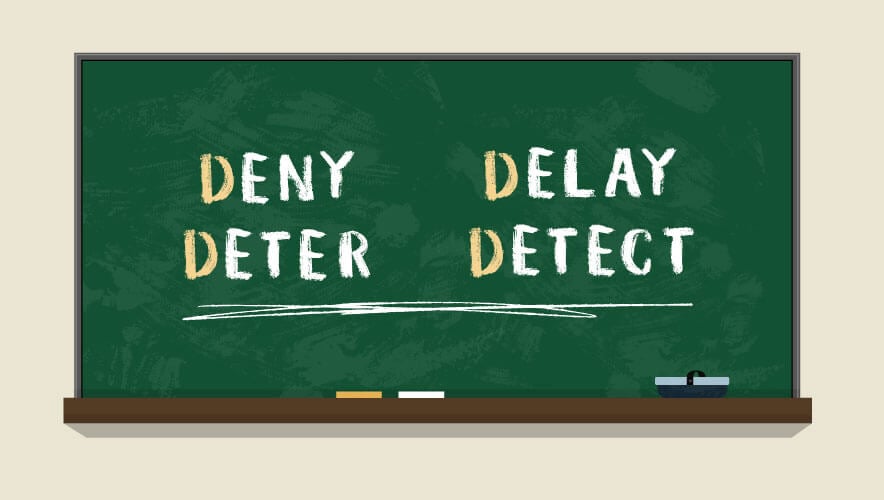Weighing Student Development in K-12 Behavioral Threat Assessment
“I hate everything.” “I don’t ever feel happy.” “I’m going to hurt you.” These phrases are alarming and should spark concern, no matter who utters them. But when it comes to assessing threatening behavior in children, additional nuance comes into play.
“In K-12, children are growing and developing—they are experimenting with behaviors, they are responding to things like bullying, and so some of the things that might be indicative of an elevated violence risk in adults may not necessarily be indicative of a violence risk in children,” says C. Joshua Villines, CPP, PCI, PSP, executive director of the Human Intelligence Group. Villines is also heavily involved in the ongoing development of a new ASIS standard on school security.
“Sometimes kids are just being kids, sometimes kids are being dumb, sometimes kids are behaving inappropriately but in a way that is age-appropriate,” he continues. “You want to take the guidance from behavioral threat assessment and tailor it to the developmental stage of the population that you’re working with.”
Children are learning to cope with their emotions and new stressors, including social and educational pressures, so warning signs in adult behavioral threat assessment—apparent impulsivity or a low tolerance for frustration, for instance—can be very common in K-12 students.
Through behavioral threat assessment, school teams can seek to answer: If a student made a threat, does that student pose a threat?
Security professionals and behavioral threat assessment teams need to evaluate comorbidities that would layer up with impulsive or disruptive actions to increase the likelihood that a child will lash out or cause harm, Villines says. Those comorbidities could include an ongoing pattern of disruptive or dysregulated behavior, access to weapons (particularly in a region where firearm access is uncommon or heavily restricted, such as in urban areas), sudden changes in self-care (such as cleanliness or nutrition), or behaviors indicative of psychosis.
“Behavioral threat assessment is intended to be preventative,” Villines says. “It does integrate very well with traditional crime prevention measures because once you’ve identified those behaviors of concern, when it comes to managing them, many of the management strategies that we employ to adjust the security posture of the location are traditional physical security measures.” Those measures can include deploying personnel or changing up access control, but effective threat assessment and intervention also involves management strategies outside traditional security, including bringing in mental health, conflict resolution, or anger management resources, which is where non-security professionals are invaluable.
Behavioral threat assessment typically includes people from three main pillars: administration, law enforcement or security, and mental health, says Amy Lowder, director of student safety and wellbeing at Cabarrus County Schools in North Carolina.
Each individual brings different things to the table: the administrator represents the school and is more likely to have a relationship with the student in question; school resource officers (SROs) or law enforcement personnel can highlight legal, compliance, and social services needs; and mental health professionals can focus on prevention and student support, she explains.
“All of those different lenses come together, and that’s how we can have a collaborative, comprehensive threat assessment process where we are really looking at those different facets,” Lowder says. For example, an administrator might note that a student has had outbursts in the classroom and disciplinary action recently, and a school counselor could chime in that the student’s parents recently separated, building a more complete picture of the student’s situation. Those pieces of information can support a threat assessment, an intervention plan to aid the student, and then a monitoring plan to ensure the intervention is working.
At least one of the people in the threat assessment team should be an educator who can attest to age and cultural norms (such as if a bizarre and vaguely threatening phrase comes from a hit TV show or TikTok influencer that has been the talk of the classroom) and a mental health professional who has a strong background in mental health and developmental markers, Villines adds.
“While there are practitioners like me who are intended to bring a level of expertise and forensic professionalism to the process, rarely do any of us work alone,” Villines says.
This team approach enables schools to take a more nuanced and trauma-informed approach to threat assessment and management, says Dr. Dewey Cornell, a clinical psychologist who has been studying school violence since the 1990s. Cornell is also involved in the development of the ASIS standard on school security.
“I recall a school principal who said, ‘I’ll just remove any student who says, “I’m going to kill you.”’ Well, it turns out threats to kill are very, very common in elementary school, and they’re overreactions,” Cornell says.
When it comes to those threats and other traditional early warning signs in adults, school behavioral threat assessment teams need to weigh and assess them differently. “When an adult says ‘I’m going to kill you,’ that’s quite concerning and frightening,” Cornell says. “When a 6-year-old says it, in some circumstances, yes, it’s frightening but for the most part not. We have to take into account the person’s age and capability, their maturity… There has to be that developmental context.
“The other thing that is different is the stakes,” he continues. “We’re trying to educate students whether they like it or not, or want to or not, so we’re often trying to work with kids who have problems, needs, challenges, and traumas. That always has to be a factor.”
The biggest source of school violence is fistfights, Cornell says. In a workplace, this is clearly unacceptable behavior, and the employer can take actions to terminate or punish the individuals involved. In a school, however, there must be some degree of tolerance, he says—if every kindergartener who hit or shoved a classmate were expelled, classrooms would soon be empty. Instead, threat assessment teams can emphasize conflict resolution as well as discipline in a productive way.
Trauma-informed and restorative practices around threat assessment look different for each individual student, but generally they are designed to help the child manage their emotions and stressors, gain coping mechanisms, and return to the learning environment.
“Trauma and stress generally can play a huge role in threatening behavior,” Cornell says. “Every kid who makes a threat, think of them as saying ‘I’ve got a problem I don’t know how to solve. Something has happened, and I don’t know how to deal with it.’ The last resort is to make a threat of violence.”
Students’ behavior can also be misunderstood as threatening. Villines recalls a neurodivergent student whose behavior seemed antisocial and concerning. Educators and school psychologists took steps to work with that student on prosocial strategies, teaching the child how to interact more positively with others. This improved the whole educational environment while enabling that child to grow and learn new skills, Villines says.
Social skills are also rapidly changing in K-12 students because of stress, upheaval, and remote learning during the COVID-19 pandemic, Lowder says. This means that some student behavior or emotional reactions to situations can seem extremely out of place to adults, who grew up in a very different school environment.
During the COVID-19 pandemic, “lots of isolation led to people not even understanding conflict resolution,” Lowder says. “That’s something that students typically struggled with. It’s a developmental thing you go through—understanding how to deal with differences and division. But when the pandemic was happening, there was also a lot of disunity across the nation and the segregation of different types of groups or beliefs, whether political, racial, or gender. All those things just festered. Then once students got back together again, it was almost like people didn’t know how to handle the commotion. It’s taken a bit of time for schools to get readjusted.”
In addition, the pandemic pushed more people to focus on their digital lives for interaction when in-personal socialization was off the table. As a result, more children are using social media, but they are using it inappropriately because most children are ill-equipped to actually manage the pressures of socializing online, she adds.
“We are finding that the majority of cases that come through, there is some type of social media element,” Lowder says. “There is oftentimes a threat made, cyberbullying is on the rise, and that’s definitely prevalent in social media.”
But social media activity should usually be taken in context with other actions rather than as a standalone trigger for intervention, Cornell cautions.
“The vast majority of times, kids are showing off, getting attention, maybe they’re in an argument with somebody and they say sometime provocative,” he says. “This is just a red flag that you then have to pursue with interviews, with visits. We need skills in digital threat assessment—you have to be reasonably familiar with the social media that kids in your school are using and have some skill at searching it, making records of things that are concerning, and then you pursue and investigate.”
Having a process in place for behavioral threat assessment and management enables schools to resist knee-jerk reactions related to a fear of school shootings, Cornell says. In 80 percent of cases, threatening behavior can be quickly resolved, and most of the remaining 20 percent relate to fistfights or minor altercations, he says. Just 5 percent of cases might involve a substantive threat that requires a more in-depth analysis, determining if the child has other stressors, home challenges, or developmental roadblocks that could heighten the risk posed to themselves or others. Having a process in place to investigate reports, evaluate threats, and provide resources as needed can calm fears and make threat assessments more fair, effective, and manageable for staff.
Although some interventions will need to be physical security ones—metal detectors, restricting student bag sizes in hallways or classrooms—Cornell notes that school officials will need to strike a balance between hardware and “heart-ware.”
“We want school security people and school resource officers to be relationship-builders,” Cornell says. “Law enforcement knows this in terms of community-oriented policing. You want to be part of the community, linked to the community, and then the community will come forward and share information with you. That’s really what threat assessment hinges on. You cannot do threat assessment if you don’t have people willing to share information to report what they’ve seen or heard. You can’t do that if you don’t have a climate where people feel comfortable.”
Successful security professionals in this area will have empathy, good communication skills, and an interest in being able to interact and talk with kids. This establishes the security officer as a trusted adult that students can confide in about potential threats or problems.
“It doesn’t have to be that fancy,” Cornell says. For example, he recalls an SRO in Tennessee who started a fishing club for kids who didn’t have another club or group where they could fit in. “It was a very relaxed, laid-back, low-stress activity,” he says, noting that not everyone wants to play sports or perform on stage, but everyone can learn to fish. “He gathered a lot of kids who just wanted to be part of a group and be accepted... It’s not rocket science, but I was just very taken that he had this novel idea and it worked.”
In North Carolina schools, Lowder started hosting awareness talks for the community, including students and parents, about behavioral issues, trending activities, and mental health support. These talks encourage more connection across the community and help build up partnerships between law enforcement, school officials, parents, and mental health professionals. Cabarrus County Schools also implemented weekly discussion topics across the school district so that all grade levels can focus on the same social-emotional subject but in developmentally appropriate ways. For instance, Lowder says, one week focused on perseverance and how to build up that skill. Broadly, these sessions are intended to boost students’ personal resilience.
“Resilience is a huge protective factor that is oftentimes overlooked in schools,” she says. “It’s being able to help students understand emotional regulation… We train students on how to get their brain back in line and get their emotions regulated. It’s an immediate reset that teachers have been able to do in the classroom. Even taking a sip of water can be a simple solution. We’re trying to help students know that they’ve got a toolbox of different things that they can do to build that resilience, reconnect to their emotions, and start to make logical decisions about how they’re feeling.”
Claire Meyer is managing editor of Security Management. Connect with her on LinkedIn or contact her directly at [email protected].

















